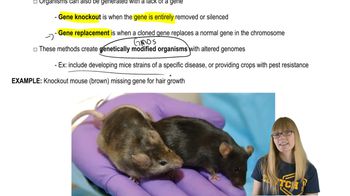Here are the essential concepts you must grasp in order to answer the question correctly.
Homologous Recombination
Homologous recombination is a genetic process where two similar or identical DNA sequences exchange genetic information. This mechanism is crucial for repairing DNA and is often exploited in genetic engineering to introduce specific changes in an organism's genome. In constructing transgenic organisms, such as mice and yeast, homologous recombination allows for precise insertion of desired genes, ensuring that the modifications are stable and heritable.
Recommended video:
Recombination after Single Strand Breaks
Transgenic Organisms
Transgenic organisms are those that have been genetically modified to contain DNA from another species. This is achieved through various techniques, including homologous recombination, which allows for the integration of foreign genes into the host genome. The creation of transgenic mice and yeast serves different purposes, such as studying gene function, producing proteins, or developing models for human diseases.
Recommended video:
Transgenic Organisms and Gene Therapy
Gene Targeting Techniques
Gene targeting techniques are methods used to modify specific genes within an organism's genome. In mice, techniques like CRISPR/Cas9 and traditional homologous recombination are employed to create knockout or knock-in models. In yeast, similar strategies are used, but the simpler cellular structure allows for more straightforward manipulation. Understanding these techniques is essential for comparing the efficiency and outcomes of creating transgenic organisms in different species.
Recommended video:
 Verified step by step guidance
Verified step by step guidance Verified video answer for a similar problem:
Verified video answer for a similar problem:

